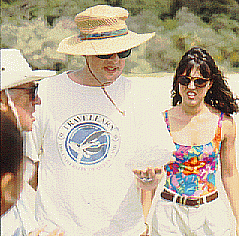
Raised in the south west of England, Ian spent his early years fossicking on the shores of the English Channel. He pursued his interest in marine life by taking an honours degree in Marine Biology at the University of Wales and then travelled to Australia to commence a Ph.D. in Zoology.
Alongside the research for his thesis, Ian became involved in teaching marine biology, both to undergraduate students and to visitors to Australia. Various opportunities led to him to continue his involvement with community and undergraduate education, and work for the Australian Government fisheries research organization. For a period, Ian was involved in the management of educational travel programs with the TraveLearn unit at The University of Queensland.
Upon completion of his PhD studies on the biology and ecology of garfish he took a lecturing position in the School of Marine Sciences at the University of Queensland where he currently administers the business of the School, gives undergraduates lectures on marine biology and supervises postgraduate students in fish biology and ecology.

Marine zoologist Ian Tibbetts discusses a type of jellyfish with students on the beach near Pt Lookout on North Stradbroke Island.
He is currently the Secretary of the Australian Coral Reef Society and Editor of the Australian Marine Science Bulletin. He lives near the shores of Moreton Bay with his wife Wendy and their three children, Daniel, Hannah and Rachel.
David Yates has been a member of the Botany Department at The University of Queensland for 17 years and a university teacher for over 20 years. He holds a Bachelor of Agricultural Science and Doctor of Philosophy Degrees from The University of Melbourne and has almost completed a Graduate Diploma in Teaching (Further Education and Training).
David is a keen teacher and teaches science and agricultural science students in a variety of subjects relating to plants and their environment, aspects of plant ecophysiology and rainforest biology. His doctoral research related to the importance of the angle of sunlight on the leaves of crop plants. His current research interests include aspects of the microclimate of rainforests and how light interacts with plant leaves.
He lived and worked in Indonesia for two and a half years and has returned there several times. He recently returned from conducting his second Indonesian Study Tour for botany, ecology and agricultural science students.
David is married to Jill who works teaching English to newly arrived migrant children for the Queensland Government. She also acted as a leader of the Indonesian Study Tours. They have two sons, one of whom is taking the second year of a Bachelor of Engineering degree, and the other is still in High School.
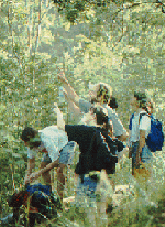
Botanist David Yates discusses a particular species of tree with students at Mt Coot-tha.
Students developed a very close relationship with both Yates and Tibbetts (first name basis), which was fostered by the field trips. It was clear that Yates and Tibbetts had the needs of the HWS students foremost in the design of the program. Both were genuinely interested in teaching which is not rewarded in a university setting in the same way that it is at the Colleges.
Assessment: Grading for the course was based on a poster project describing the climate of a selected Australian city or town, a report based on field exercises carried out at Stradbroke Island, and a final project described below.
The final project: The material for this may be drawn from any material presented in lectures, field trips, books or papers you have read, or indeed any reliable source. The aim of this exercise is for you to integrate and apply some of the information you obtain. This will require you to think! The primary tasks you will undertake in the essay are described below.
Bids 319: Biodiversity
Biodiversity refers to the variety of life
forms: the different plants, animals and microorganisms, the genes they
contain, and the ecosystems they form. This living wealth is the product
of hundreds of millions of years of evolutionary history. In places as
ancient as Australia, this history can still be seen today in 'living
fossils' whose origins date back hundreds of millions of years.
Evolution implies that
the pool of living diversity is dynamic: it increases when new genetic
variation is produced, a new species is created or a novel ecosystem
formed; it decreases when the genetic variation within a species
decreases, a species becomes extinct or an ecosystem complex is destroyed.
The concept emphasises the interrelated nature of the living world and
its processes.
The course examined diversity at three different levels:
genetic diversity, species diversity and ecosystem diversity.
The final project: Choose a particular system (ecosystem, habitat or community) and prepare a report (actual or hypothetical) concerning the biodiversity and management of the system. The report should include: a description of the system; a methods section, in which you describe how you would measure actual biodiversity and the capacity of the system; a data analysis section, in which you describe how you would treat the data (or if it is an actual study, how you treated the data and what you found); a description of the anthropogenic pressures impinging on the system; appropriate management measures/responses; illustrative examples from other areas (drawn from your own experience, reading or lectures); and, a section detailing national and international treaties which might be used in support of your management recommendations.
Math 251: Applied Statistics
For students who have not had any course in statistics, this course with its emphasis on
nonparametric statistics will offer a sound introduction to the subject. Nonparametric statistics
are an especially effective way to learn about "statistical thinking" because the statistics
themselves are often very intuitive and for small samples they can usually be calculated "by
hand".
For students who have had some statistics before, it is quite likely that you spent much of the time working with parametric statistics using statistical tests based on the normal distribution and its relatives. While these test are very powerful, the underlying assumption of the "normality" of the data set can be hard to verify for the small samples that students often collect. Nonparametric statistics provide a useful alternative in such cases.
For all students, the use of nonparametric statistics provides an environment where the concepts of hypothesis testing and confidence levels are central and calculations are relatively simple.
Text: Gottfried E. Noether: Introduction to Statistics -- The Nonparametric Way.
Topics: The main topics of the course were:
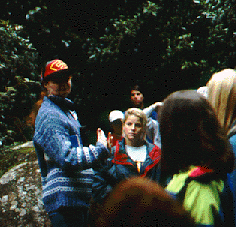
Anita Smythe leading a morning bird walk at Lamington.
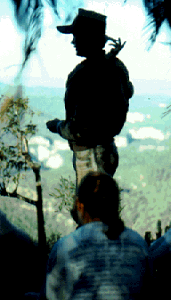
At Battleship Spur overlooking Carnarvon Gorge, Lloyd Hancock led a discussion on Aborigines' relationship to and use of the land.
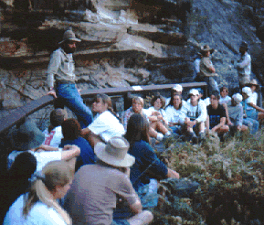
Park Ranger Gavin Enevra led a discussion on Aboriginal culture and religious beliefs at "The Tombs" in the Mt Moffat Section of Carnarvon National Park.
1. A five day trip to North Stradbroke Island
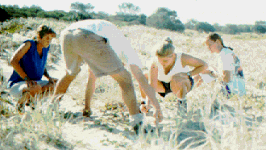
Students collected data to determine area-species curves behind the dunes near 18 Mile Swamp on North Stradbroke Island.
2. A five day trip to Lamington National Park
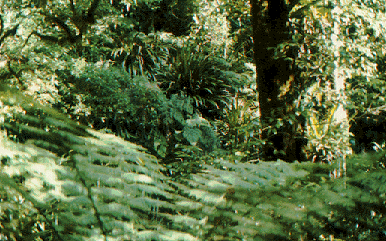
In the humid shade beneath the forest canopy, sturdy branches and tree trunks host a diverse array of orchids and ferns. On the forest floor, a complex community of ferns, sedges, saplings, mosses, fungi, and vines compete for space, water, nutrients and light. An explosion of growth occurs wherever a stream, a trail, or fallen tree provides an extra measure of light.
3. A seven day trip to Lady Elliot Island
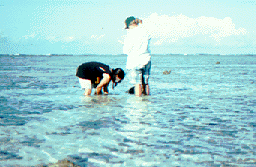
Jeanne Classen '96 and Kjerstin Todd '95 collecting species diversity data in the reef flat at Lady Elliot Island.
4. A six day trip to Carnarvon Gorge (Saddler Springs, Mt. Moffat)
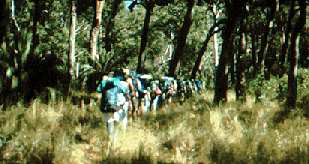
The trip to Carnarvon featured a two day hike in the low bush country near Battleship Spur.
For each trip, there were preparatory and/or on site lectures. At each location, human pressures on the particular ecosystem and management of resources were discussed. We tried to take maximum advantage of the time spent at the various locations. The time spent "on task" during the day at a field site was occasionally quite long, with instruction and data collection exercises extending over a 10 to 12 hour period.
There were two shorter half-day excursions included in the program. The first of the trips was to Mt Coot-tha, in the outskirts of Brisbane. It is a 20-minute drive from the University of Queensland campus. Our work there consisted of a series of data collection exercises (measuring tree diameters by species and location, measuring the variation in light intensity along a transect and over time, etc.) that introduced students to techniques that they would use later in the program. The data were also used in the statistics course. The second half-day excursion was to the University of Queensland Veterinary Farm for a lecture on marsupial biology and some "hands on" interaction with koalas.
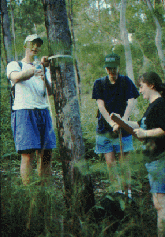
Carl Seashore '95, Amanda Fantauzzo '96, and Carol Ann Clark '95 collect data at Mt Coot-tha on tree species diversity and diameter according to location.